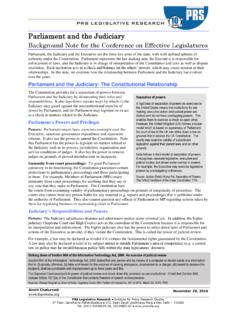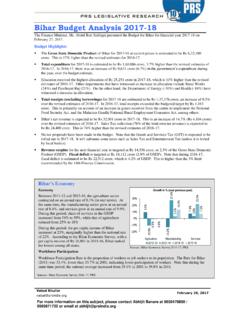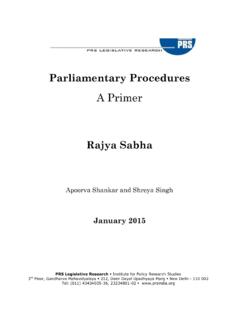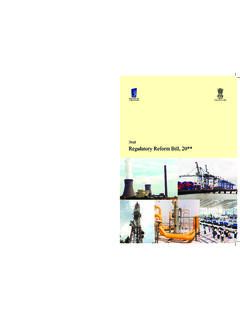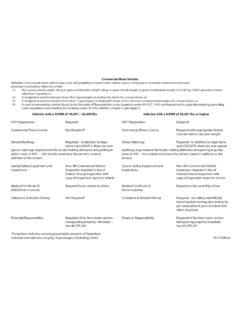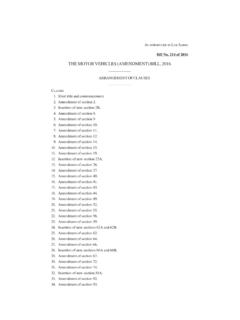Transcription of Amendments to the Motor Vehicles (Amendment) Bill, 2016
1 Prachee Mishra April 11, 2017 PRS Legislative Research Institute for Policy Research Studies 3rd Floor, Gandharva Mahavidyalaya 212, Deen Dayal Upadhyaya Marg New Delhi 110002 Tel: (011) 43434035-36 Amendments to the Motor Vehicles (Amendment) Bill, 2016 The Motor Vehicles (Amendment) Bill, 2016 was introduced in Lok Sabha on August 9, The Bill amends the Motor Vehicles Act, 1988 to address issues around third party insurance, regulation of taxi aggregators, and road safety. The Standing Committee on Transport, Tourism and Culture submitted its report on the Bill on February 8, Following that, a few Amendments to the Bill were circulated on April 7, Lok Sabha passed the Bill with these Amendments on April 10, We present a summary of issues in the 2016 Bill that have been addressed by the Bill that was passed by Lok Sabha. Table 1: Comparison between Motor Vehicles (Amendment) Bill, 2016, and the Bill as passed by Lok Sabha in April 2017 Motor Vehicles (Amendment) Bill, 2016 (2016 Bill) Bill as passed by Lok Sabha (2017 Bill) Third party insurance Third party insurance is the liability purchased from an insurer (insurance company) by person A (insured party) to protect himself against claims from person B (third party), in the event of death, injury, or damage to property.
2 Under the 1988 Act, third party insurance is compulsory for all Motor Vehicles and the liability of the third party insurer is unlimited. The 2016 Bill caps the maximum liability for third party insurance in case of a Motor accident at Rs 10 lakh in case of death and at five lakh rupees in case of grievous injury. Issue: If courts award compensation amounts higher than the maximum liability prescribed under the Bill, it is unclear who will pay the remaining amount. The 2017 Bill removes the cap on liability for third party insurance. Funds for hit and run accidents The 2016 Bill requires central government to constitute a Motor vehicle Accident Fund which would provide compulsory insurance cover to all road users in India for: (i) treatment of a person who has been grievously hurt in an accident, till he is stabilized; and (ii) compensation in case of death or grievous injury where no person can be held liable for the accident. The Fund will be credited with: (i) a cess or tax as approved by the central government, or (ii) a grant or loan made by the central government, or (iii) any other source as prescribed the central government.
3 Issue: With the Solatium Fund already existing under the Act, the purpose of the new Motor vehicle Accident Fund with regard to hit and run cases is unclear. For example, there is no clarity on whether accident victims can seek compensation (for a particular hit and run case) from either or both the funds. Further, if the proposed Motor vehicle Accident Fund is funded through a cess or a tax, Motor vehicle owners may have had to pay taxes in addition to paying the compulsory third party insurance premiums. The 2017 Bill specifies that the Motor vehicle Accident Fund will be utilised for: (i) treatment of persons injured in road accidents in accordance with the golden hour scheme, (ii) compensation to representatives of a person who died in a hit and run accident in accordance with schemes framed by central government, (iii) compensation to a person grievously hurt in a hit and run accident in accordance with schemes framed by central government, and (iv) compensation to persons as prescribed by the central government.
4 The requirement of crediting the Fund with a cess or tax has been removed. As per the 2017 Bill, the Motor vehicle Accident Fund will be credited through: (i) payment of a nature notified and approved by the central government; or (ii) a grant or loan made by the central government; or (iii) balance of the Solatium Fund, as it stood immediately before the commencement of the Bill; or (iv) any other source as prescribed the central government. Scheme for providing interim relief to claimants seeking compensation under third party insurance The 2016 Bill allows the central government to make a scheme for providing interim relief to claimants seeking compensation under third party insurance for Motor vehicle accidents. Any contravention of any provision of the scheme may be punishable with imprisonment of up to two years, or with a fine between Rs 25,000 and five lakh rupees. Issue: While the Bill specifies penalties for contravening provisions of this scheme, it does not specify the offences that would warrant such penalties.
5 The government may specify these offences through a notification for the scheme. The question is whether it is appropriate to delegate the function of specifying offences to the executive. The 2017 Bill removes the provisions related to penalties under the scheme. Guidelines for aggregators The 2016 Bill defines aggregators as digital intermediaries or market places which can be used by passengers to connect with a driver for transportation purposes (taxi services). State governments will issue licenses to aggregators in conformity with guidelines issued by the central government. Issue: The 2016 Bill does not specify what the central guidelines will cover. Currently, state governments determine guidelines for taxis ( , the rules that govern plying of the vehicle ). With regard to aggregators, there could be cases where such state guidelines are at variance with the central guidelines. In such a scenario, the central guidelines will prevail because Motor Vehicles laws fall under the Concurrent List in the Seventh Schedule to the The 2017 Bill makes it optional for states to follow central government guidelines on aggregators.
6 Agency responsible for road safety The Sundar Committee on Road Safety had observed that India does not have a road safety The existing institutions in India do not have the required capacity to look into road safety. The responsibility for road safety is diffused across various bodies, and there is no effective coordination mechanism between these bodies. The Sundar Committee had recommended setting up Road Safety and Traffic Management Boards at the national and state levels. These authorities would: (i) set standards and conduct audits with regard to roads, (ii) prescribe vehicle safety features, (iii) conduct road safety research, and (iv) recommend guidelines with regard to driver licensing and vehicle registration. The 2017 Bill provides for a National Road Safety Board, to be created by the central government through a notification. The Board will comprise of a Chairman, representatives of the state governments, and other members as specified by the central government.
7 The Board will provide advice to the central and state governments on all aspects of road safety and traffic management including: (i) standards of design, weight, manufacturing process, operation and maintenance of Motor Vehicles , (ii) registration and licensing of Vehicles , (iii) formulating standards for road safety, road infrastructure and control of traffic, (iv) promotion of new vehicle technology, and (v) safety of vulnerable road users. The central government may make rules regarding the terms and conditions of appointment if the Board, and other functions of the Board. Road design and engineering Currently, there are no legally mandated standards for road design and engineering in India. While the Indian Road Congress provides guidelines for road design, these are not mandatory or binding. The National Transportation Development Policy Committee had noted that badly designed roads should be held responsible for road accidents instead of bad The 2017 Bill provides that any contractor or consultant responsible for the design, construction, or maintenance of the safety standards of roads must follow design, construction and maintenance standards specified by the central government.
8 Failure to comply with such standards will be punishable with a fine of up to one lakh rupees, and such amount will be credited to the Motor vehicle Accident Fund. The 2017 Bill also specify certain road design characteristics that the Courts should consider when looking at such cases. These include: (i) characteristics of the road and the type of traffic which was expected on it, (ii) standard maintenance norms for roads, and (iii) the state of repair in which road users would have expected to find the road. Sources: The Motor Vehicles (Amendment) Bill, 2016; Motor Vehicles (Amendment) Bill, 2017, as passed by Lok Sabha; PRS. Other additional changes in the 2017 Bill (as passed by Lok Sabha) include: Accident information report: Under the 2016 Bill, a police officer will prepare an accident information report to facilitate the settlement of claims, and submit it to the Claims Tribunal. The 2017 Bill specifies a time limit of three months to submit the accident information report.
9 Settlement of claims: Under the 2016 Bill, an insurance company on receiving information related to an accident through an accident information report, will designate an officer to settle claims related to the accident. The 2017 Bill passed by Lok Sabha, provides that the insurance company can process claims on receiving information from the claimant also. Further, the insurance company must settle claims within a time limit of 30 days. Application of compensation: A time limit of six months has been specified for an application of compensation to the Claims Tribunal with regard to road accidents. The Act did not provide for any such time limits. Recovery of compensation amounts: Provisions under the 2016 Bill allowing third party insurance companies to recover compensation amounts from the vehicle owners have been removed. Revision of fines: The central government may increase fines mentioned under the Act every year by up to 10%.
10 Removal of Second Schedule: The 2017 Bill removes the Second Schedule to the Act. This Schedule provides for the manner of calculation of compensation for road accidents resulting in death or injury. 1 The Motor Vehicles (Amendment) Bill, 2016, Ministry of Road Transport and Highways, August 9, 2016, ,%202016/ Motor %20 Vehicles %20%28 Amendment%29%20 Bill,% 2 243rd Report: The Motor Vehicles (Amendment) Bill, 2016, Standing Committee on Transport, Tourism and Culture, February 8, 2017, ,%202016/SCR-%20 Motor %20 Vehicles %20 Bill,% 3 Notice of Amendments , The Motor Vehicles (Amendment) Bill, 2016, As introduced in Lok Sabha, April 7, 2017, ,%202016/ Motor %20 Vehicles %20notice%20of%20amendment%20 Apr%205-% 4 The Motor Vehicles (Amendment) Bill, 2017, As passed by Lok Sabha, April 10, 2017, 5. Entry 35 of the Concurrent List of the Constitution. 6 Report of the Committee on Road Safety and Management, February 2007, 7 Volume 3, Chapter 2, Roads and Road Transport , India Transport Report: Moving India to 2032, National Transport Development Policy Committee, June 17, 2014, DISCLAIMER: This document is being furnished to you for your information.
